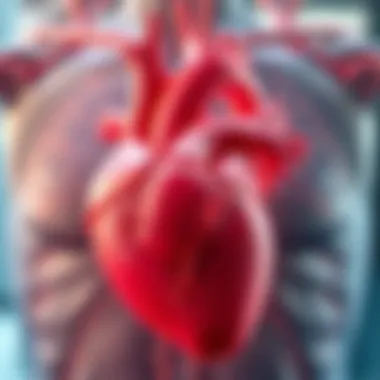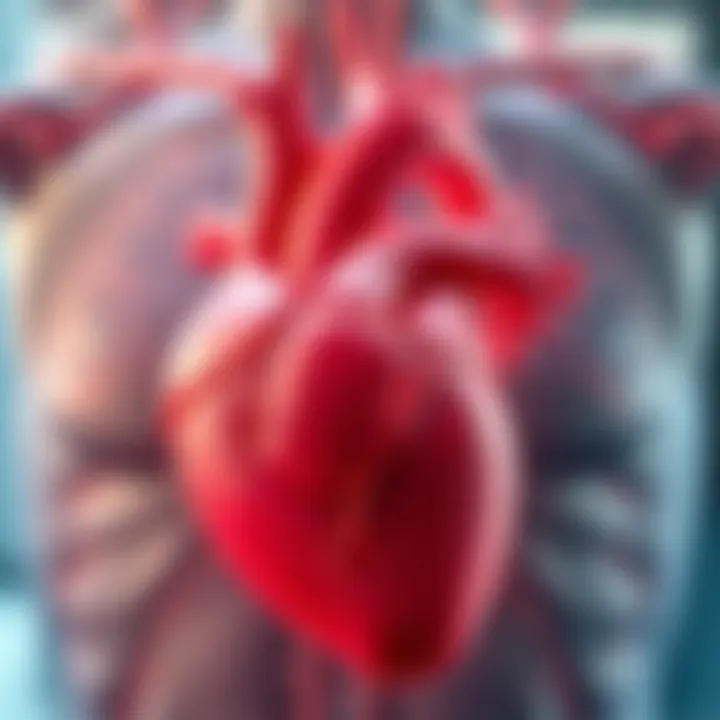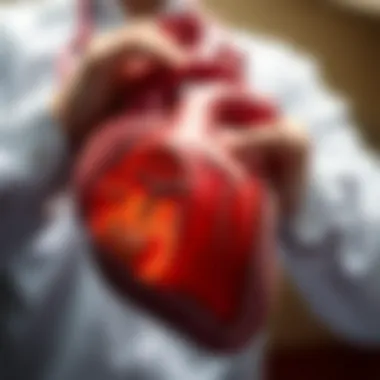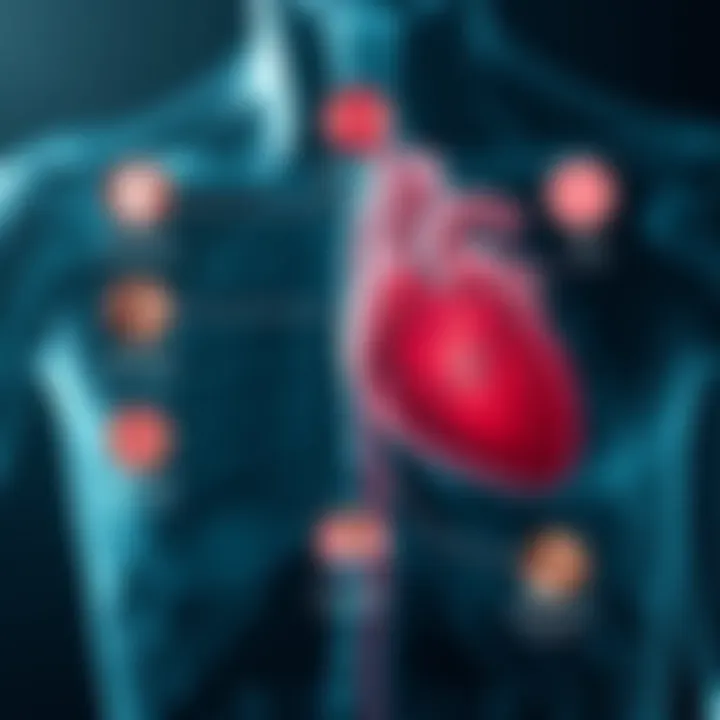Understanding End Stage Heart Disease: Comprehensive Insights


Intro
End stage heart disease represents a critical juncture in the journey of cardiac health, where the heart's efficiency plummets and the patient faces daunting challenges. For medical professionals, understanding this stage is not only a matter of treating the condition but also providing a compassionate approach that addresses the holistic well-being of the individual. This article delves into the intricacies surrounding end stage heart disease, a topic that demands comprehensive examination given its profound implications for patients and healthcare providers alike.
As we navigate through various aspects of this condition, from its definition, symptoms, and causes, to the latest diagnostic methods and treatment avenues, the goal is to foster a robust understanding that can empower both clinicians and caregivers. The discussion will aim to elucidate the physiological mechanisms driving the disease process, while also shining a light on patient management strategies that enhance quality of life even in the face of severe illness.
In this article, we will clarify the gravity of end stage heart disease in the broader context of cardiovascular health. At its core, this exploration is about establishing informed connections—not only among healthcare practitioners working in cardiology but also with researchers, educators, and students who are navigating the complexities of this condition.
Definition of End Stage Heart Disease
End Stage Heart Disease (ESHD) marks a pivotal point in the trajectory of cardiovascular afflictions. Understanding this condition is crucial not just for healthcare professionals, but also for patients and their families, as it lays the groundwork for critical decisions regarding treatment, care, and lifestyle changes. Operating under the umbrella of heart disease, ESHD signifies the final phase where the heart can no longer effectively pump blood to meet the body’s demands, leading to a cascade of complications. Without a grasp of its definition, one might misinterpret the nuances of this life-altering diagnosis.
Such a profound condition raises questions about quality of life and available palliative options. For any patient facing heart failure, knowing what ESHD entails aids in navigating through emotional upheaval and assembling support systems for medical management. It's not just about the biological deterioration; it's entwined with intricate social implications and the often complex emotional landscape that follows.
In discussing ESHD, we consider two primary facets: medical terminology and stage classification. These elements provide a clearer picture for health professionals and patients alike, fostering meaningful dialogues around treatment plans and expectations. Understanding the terms that describe this stage allows families and providers to work collaboratively, thus enhancing the management process.
Pathophysiology
Understanding the pathophysiology of end stage heart disease is crucial because it lays the groundwork for how the body responds to this dire condition. At this point, the heart can no longer meet the metabolic demands of the body. There are significant shifts in heart function, structural changes, and biochemical pathways. Grasping these processes equips healthcare professionals and patients alike with vital knowledge to navigate the complexities of the disease. It also fosters an awareness of potential developments and innovations in treatment approaches that could significantly alter the patient experience.
Cardiac Function Failure
When discussing cardiac function failure, we delve into the heart’s inability to pump sufficient blood to satisfy the needs of tissues. This may arise from a variety of underlying issues, but at the end stage, it often reflects a culmination of progressive damage over time. The heart muscle might grow weak or stiff due to factors like coronary artery disease or chronic hypertension, which means it can't fill up or contract properly.
Patients may experience symptoms that ebb and flow, but eventually, these become more pronounced. Blood flow issues lead to a cascade of effects: reduced oxygenation of tissues, organ dysfunction, and systemic complications. The heart fails not just in isolation but affects the larger network of the body.
"A heart in failure is like a ship with a hole in it; no matter how much effort goes into patching it, it’s still going to sink unless the source is addressed."
"A heart in failure is like a ship with a hole in it; no matter how much effort goes into patching it, it’s still going to sink unless the source is addressed."
In this stage, the heart compensates for decreased efficiency by enlarging, thickening, or remodeling itself, a process that, over time, becomes counterproductive. It’s a precarious balancing act, trying to sustain function while preventing further deterioration. Understanding these changes is essential for anticipating patient needs and tailoring intervention strategies.
Compensatory Mechanisms
The heart, in times of distress, begins to engage compensatory mechanisms, often aiming to preserve blood flow and maintain perfusion to critical organs. The body can activate several strategies, including:
- Increased Heart Rate: Initially, the heart may pump faster to maintain cardiac output. Yet, this is a temporary fix; over time, the heart tires out.
- Neurohormonal Activation: Hormones like norepinephrine flood the system to tighten blood vessels and increase blood pressure, but excessive activation can be detrimental in the long run.
- Utilization of Other Vascular Systems: Blood vessels in other parts of the body may constrict to prioritize blood flow to vital organs like the heart and brain, a maneuver that isn’t sustainable.
These mechanisms reflect the body’s innate resilience. However, as these compensatory efforts continue unchecked, they can lead to further complications—sometimes making matters worse rather than better. Understanding these compensatory processes allows practitioners to anticipate the needs of their patients and adjust treatment plans appropriately.
Grasping the pathophysiology of end stage heart disease can indeed pave the way for more informed medical decisions, contributing significantly to patient care.
Causes of End Stage Heart Disease
Understanding the causes of end stage heart disease is crucial in this article as it lays the foundation for recognizing risk factors and implementing preventive measures. Awareness of these causes provides essential context for healthcare professionals and individuals navigating this complex condition. Identifying the underlying issues allows for targeted approaches in treatment and management, ultimately leading to better patient outcomes.
Coronary Artery Disease
Coronary artery disease (CAD) is often at the heart of end stage heart disease. This condition occurs when the coronary arteries, which supply blood to the heart muscle, become narrowed or blocked because of plaque buildup. This reduction in blood flow can lead to a heart attack, which might transition into end stage heart disease over time. One key aspect here is that lifestyle factors, such as poor diet and lack of exercise, significantly contribute to the development of CAD. Additionally, genetics also play a role—some individuals may inherit a predisposition towards developing this condition.
Key Points about Coronary Artery Disease:
- It often develops over many years and can be asymptomatic until it becomes severe.
- Symptoms might not emerge until significant damage has occurred, which complicates early detection.
- Effective management can include dietary changes, exercise, and medications aimed at lowering cholesterol levels.
Hypertension
Hypertension, or high blood pressure, is another major contributor to the development of end stage heart disease. This condition puts added strain on the heart due to the increased pressure in the arteries. Over time, this can lead to heart muscle damage, and if untreated, it often progresses to heart failure. The relationship between hypertension and heart disease is well-documented, making it vital for individuals to monitor their blood pressure consistently.
Important Considerations on Hypertension:
- It can be caused by factors such as diet, stress, and even certain underlying health conditions.
- Regular check-ups and blood pressure measurements are crucial for early intervention.
- Treatment options typically include lifestyle modifications alongside antihypertensive medications.
Cardiomyopathy
Cardiomyopathy refers to a group of diseases that affect the heart muscle's ability to pump blood efficiently. This condition can be genetic or acquired, often linked with prior heart issues or even prolonged hypertension. As the heart muscle weakens, it can lead to arrhythmias or heart failure, putting patients at risk of end stage heart disease. In some cases, it progresses without noticeable symptoms until it reaches a critical point, emphasizing the importance of understanding its causes.
Key Aspects of Cardiomyopathy:
- Types include dilated, hypertrophic, and restrictive cardiomyopathy, each with its own implications.
- Diagnosis typically involves imaging and functional testing, aiming for early detection.
- Management may involve medications, lifestyle adjustments, and in severe instances, surgical interventions.
Other Risk Factors
In addition to CAD, hypertension, and cardiomyopathy, several other risk factors can lead to end stage heart disease. These may include:
- Diabetes: It can cause damage to blood vessels, increasing the risk for heart disease.
- Obesity: Excess weight can place significant strain on the heart.
- Smoking: Tobacco smoke damages blood vessels and can bring about heart disease much quicker.
- Sedentary Lifestyle: Lack of physical activity can contribute to multiple cardiovascular risk factors.
- Chronic Kidney Disease: This can exacerbate heart issues due to fluid retention and reduced blood pressure control.


"Understanding the different causes of end stage heart disease is key for prevention and management strategies that can enhance quality of life."
"Understanding the different causes of end stage heart disease is key for prevention and management strategies that can enhance quality of life."
Each individual's path to end stage heart disease can vary greatly. Recognizing the multiplicity of causes is essential for healthcare practitioners and patients alike, as it shapes informed decision-making and fosters proactive health strategies.
Signs and Symptoms
Understanding the signs and symptoms of end stage heart disease is crucial for both healthcare practitioners and individuals affected by this condition. Recognizing these indicators not only aids in timely medical intervention but also allows for improved management of care strategies, which can significantly impact patient quality of life. The signs are often the body’s way of signalling that something isn’t right, providing a window into the severity of the heart's condition. When one understands these symptoms clearly, it leads to better communication with healthcare providers and can assist in navigating treatment decisions.
Fatigue and Weakness
Fatigue is often one of the most pervasive symptoms in individuals with end stage heart disease. It can be so profound that patients might describe feeling unusually tired even after adequate rest. The heart’s diminished ability to pump blood effectively means that less oxygen reaches the muscles and organs, resulting in weakness. This can make even routine activities feel like climbing a mountain.
- Common triggers of fatigue include:
- Physical exertion, even if minimal.
- Emotional stress, which can exacerbate physical fatigue.
- Lack of sleep due to discomfort from other symptoms.
In many stories from patients, fatigue can lead to feelings of inadequacy, affecting self-esteem and emotional well-being. It’s also key to consider that fatigue might not just stem from the physical aspect of the heart condition but can also be influenced by the psychological burden that comes with chronic illness.
Shortness of Breath
Another significant symptom experienced frequently is shortness of breath, medically known as dyspnea. This can occur at rest or during physical activity, and in advanced cases, it can even happen while lying flat, known as orthopnea. The underlying reason is directly related to the heart's inefficacy in pumping blood, which in turn causes fluid to build up in the lungs, a condition called pulmonary congestion.
- Manifestations of shortness of breath can be:
- Sudden onset, catching the patient off guard.
- Gradual progression over weeks or months.
People often share their discomfort during instances of shortness of breath, feeling vulnerable and anxious with each labored breath. This symptom is particularly critical to monitor, as it can indicate worsening heart failure and necessitate immediate medical attention.
Swelling and Edema
Swelling, particularly in the lower extremities, is another common hallmark of end stage heart disease. This condition, known as edema, develops when excess fluid builds up in the body’s tissues. Its prevalence is often notable around the ankles and legs, although it can occur in the abdomen and other areas.
- Potential causes of edema include:
- Increased sodium intake.
- Prolonged standing or sitting.
- Ineffective function of medications.
Patients tend to find this symptom disheartening; it can be related to a feeling of shame about their body image, contributing to mental strain. Edema isn’t just a cosmetic concern; it signals fluid overload and potential heart failure exacerbation, requiring careful management.
Chest Pain and Discomfort
Chest pain is perhaps one of the most alarming symptoms associated with heart disease. In end stage heart disease, this pain or discomfort can arise from several factors, including ischemia due to clogged arteries or heart muscle strain due to overwork. Patients might describe the sensation as tightness, pressure, or an outright ache.
- Different types of chest pain can include:
- Angina pectoris: typically a transient pain.
- Heart attack symptoms: potentially more severe and prolonged.
Many narratives convey the sheer fear that accompanies chest pain, often leading to thoughts of impending doom. It’s critical to understand that while not all chest pain is life-threatening, in the context of end stage heart disease, it demands prompt evaluation.
"Early recognition of these signs can help navigate treatment decisions more effectively and ensure that the patient's needs are met promptly."
"Early recognition of these signs can help navigate treatment decisions more effectively and ensure that the patient's needs are met promptly."
In summary, monitoring signs and symptoms such as fatigue, shortness of breath, swelling, and chest pain provides valuable insights into the state of heart health in patients. A nuanced understanding of these indicators can lead to better overall management and can significantly enhance the quality of life for those afflicted with end stage heart disease. For further reading on heart disease, consider visiting Mayo Clinic or American Heart Association.
Diagnostic Approaches
Diagnostic approaches in the context of end-stage heart disease are crucial for effective management. Identifying the severity and specific characteristics of heart disease allows healthcare professionals to tailor treatment effectively. A thorough diagnostic process not only enhances patient outcomes but also informs decision-making regarding interventions. This phase of assessment determines the most appropriate management strategies and provides insights into what the future might hold for the patient.
Clinical Assessment
The first step in diagnosing end-stage heart disease often begins with a rigorous clinical assessment. This involves a detailed patient history and physical examination. The clinician will review symptoms, medical background, and family history that might indicate heart-related issues.
During the examination, doctors may note key physical findings such as:
- Abnormal heart sounds
- Swelling in the legs or abdomen
- Changes in blood pressure
These observations provide a starting point to understand the patient’s condition better. Engaging in dialogue with patients about their experience enables healthcare providers to assess the overall impact on their quality of life.
Imaging Techniques
Imaging techniques play a pivotal role in visualizing the heart's structure and function. These methods help in confirming a diagnosis and outlining the treatment path. Different imaging modalities include:
Ultrasound
Ultrasound is a cornerstone of cardiac imaging, often referred to as echocardiography. This technique employs sound waves to produce images of the heart, offering real-time views of heart motion and anatomy. One of the standout features of ultrasound is its non-invasive nature, making it a popular choice among clinicians.


The advantages of ultrasound include:
- Real-time imaging: It allows doctors to observe the heart's function during exams.
- No radiation exposure: This makes it safer, especially for ongoing monitoring of patients.
However, ultrasound can have limitations such as operator dependency and difficulty visualizing certain anatomical areas in obese patients.
CT Scans
Computed Tomography (CT) scans provide high-resolution images and are especially useful in assessing coronary artery disease. The key characteristic of CT is its ability to give cross-sectional images of the heart, allowing for detailed evaluations of heart structures and blood vessels.
CT scans boast an advantage of quick image acquisition, which can be vital in acute situations. However, a notable point of concern is the exposure to radiation, which raises questions about its long-term impacts on health. Dr. Smith outlines this concern, stating, "While CT scans are invaluable in diagnostics, we must weigh the risks against their benefits in particular cases."
MRIs
Magnetic Resonance Imaging (MRI) is another sophisticated imaging technique utilized in the assessment of heart disease. This method is unique due to its ability to produce detailed images without using ionizing radiation. MRIs stand out for their capacity to evaluate both the structure and function of the heart with exceptional clarity.
Key features of MRI include:
- No radiation: This is a significant benefit, especially for patients requiring multiple scans over time.
- Functional analysis: It can assess blood flow and heart muscle viability effectively.
Nonetheless, MRIs may not be suitable for all patients, especially those with certain implanted devices or claustrophobia issues.
Laboratory Tests
Laboratory tests complement clinical assessments and imaging by providing critical data points. Blood tests can reveal levels of biomarkers that indicate heart stress or damage, such as Troponin and B-type Natriuretic Peptide (BNP). These markers help gauge the seriousness of heart involvement and guide treatment approaches.
Functional Testing
Functional testing involves assessing how well the heart performs under stress. This can include exercise stress tests or pharmacological stress tests for patients unable to exercise. These tests can uncover abnormalities that may not be apparent during rest and provide insight into the heart's capacity to function during physical activity.
Treatment and Management Strategies
Effectively managing end stage heart disease is a pivotal aspect that can not only prolong life but also improve its quality. Treatment strategies are tailored to meet the unique needs and circumstances of each patient. Understanding the available options ensures that patients and their families make well-informed decisions regarding care plans. This section dives into the pharmacological treatments and surgical interventions, as well as the role of palliative care.
Medication Management
Management of end stage heart disease often begins with medication. Various classes of drugs play a role in alleviating symptoms and extending survival. Below are the key categories of medications commonly used in treatment.
Diuretics
Diuretics are often labeled as the "water pills," and for good reason. They help the body eliminate excess fluid by promoting urination. This characteristic can significantly relieve symptoms such as swelling and shortness of breath, common issues faced by those with heart difficulties.
A standout point about diuretics is their ability to regulate blood pressure indirectly. By reducing blood volume, they ease the burden on the heart. However, it's crucial to monitor electrolyte levels when using these medications. Their advantage lies in quick symptom relief, but high doses can lead to dehydration and other complications.
ACE Inhibitors
Angiotensin-converting enzyme (ACE) inhibitors serve a vital function in managing blood pressure and heart function. They work by relaxing blood vessels, thereby improving blood flow and reducing the workload of the heart. Patients benefit from this dramatically, especially those with heart failure.
What's unique about ACE inhibitors is their dual role: they not only manage high blood pressure but also protect the kidneys. However, they can have side effects, such as cough and elevated potassium levels. The decision to start this treatment often hinges on individual patient profiles and health conditions.
Beta-blockers
Beta-blockers are primarily known for their heart rate management capabilities. By slowing the heart down, they lessen the demand for oxygen, making them quite beneficial for patients with severe heart conditions. They can also reduce the risk of arrhythmias.
The interesting facet of beta-blockers is their effectiveness in enhancing exercise tolerance, which can improve a patient's quality of life. However, a word of caution: these meds aren’t suitable for everyone. Some people might experience fatigue or weight gain, making careful consideration essential.
Surgical Interventions
When medications are insufficient, surgical options come into play. Surgical interventions can provide a new lease on life for patients with heart disease.
Heart Transplant
A heart transplant is often deemed the last resort for individuals facing severe heart failure. This procedure involves replacing a failing heart with a healthy one from a donor. The primary characteristic of a heart transplant is its potential to restore normal heart function, thereby vastly improving the patient's life expectancy and quality of life.
However, there are hurdles. Finding a donor heart can take time, and there's a risk of body rejection. Additionally, patients must adhere to lifelong immunosuppressant therapy to prevent rejection, which has its own set of risks and potential side effects.
Ventricular Assist Devices
Ventricular assist devices (VADs) act as mechanical pumps helping the heart. They can be a bridge to transplant or a long-term solution for those who are not candidates for surgery. VADs are particularly crucial in supporting patients who are in advanced stages of heart failure.
What sets VADs apart is their capability to increase blood flow and improve organ function without requiring major chest surgery. However, these devices come with challenges like infection risks and the need for ongoing care and monitoring.
Palliative Care
Palliative care is an essential component of managing end stage heart disease. It's not just about addressing physical symptoms but also ensuring emotional and psychological support. Specifically, palliative care aims to enhance quality of life for both patients and families during these trying times.


This approach encourages open conversations regarding goals of care and preferences. Patients benefit significantly from the specialized support teams that focus on pain management, psychological well-being, and addressing family needs. Whether it’s assistance in making tough treatment decisions or simply providing a listening ear, palliative care is vital.
Overall, navigating the treatment landscape for end stage heart disease involves a careful balance of medications and surgical interventions, accompanied by robust support systems to enhance patient quality of life.
Prognosis and Quality of Life
The prognosis and quality of life for individuals suffering from end stage heart disease are critical elements to consider in the overall understanding and management of the condition. This stage often signifies the culmination of prolonged cardiac impairment, leading to significant changes not only in the patient’s physical health but also in their psychological and social well-being. Factors such as age, comorbidities, and the nature of heart disease all play a vital role in determining outcomes. Furthermore, understanding these dynamics can influence treatment decisions and improve patient care strategies.
Survival Rates
Survival rates represent a key aspect of prognostic discussions regarding end stage heart disease. These rates vary widely, influenced by severity, treatment options pursued, and patient demographics. For instance, studies indicate that patients with advanced heart failure have a median survival rate ranging from one to five years, based largely on whether they receive interventions like heart transplants or implanted devices.
When considering survival statistics, it is paramount to take into account that many factors, including:
- Age: Older individuals often face a steeper decline in functional capacity.
- Comorbid Conditions: The presence of diabetes, kidney disease, or other chronic conditions can complicate survival rates.
- Response to Therapy: Effectiveness of medications and other treatments can dramatically alter prognosis.
Survival rates add an essential layer to discussions about advance care planning, providing patients and families with important information needed for making informed decisions.
Impact on Daily Living
The impact of end stage heart disease on daily living cannot be understated. Functional decline leads to challenges that affect everyday activities, social interactions, and emotional health. Common changes in daily life include:
- Physical Limitations: Activities such as walking or climbing stairs might become daunting, leading to increased dependency.
- Emotional Strain: Feelings of anxiety, depression, and social isolation are prevalent, as individuals cope with their condition and potential outcomes.
- Lifestyle Adjustments: Diet and activity levels often require significant changes, often needing constant management and education.
In many cases, patients may find themselves relegated to a more sedentary lifestyle, leading to further complications and decreased life satisfaction. Communication with healthcare providers about these impacts is vital, as it helps to facilitate comprehensive care that encompasses both medical and emotional support.
"Understanding the personal impact of heart disease is just as crucial as managing the clinical aspects. A focus on quality of life can offer patients a more comprehensive treatment experience."
"Understanding the personal impact of heart disease is just as crucial as managing the clinical aspects. A focus on quality of life can offer patients a more comprehensive treatment experience."
Ultimately, both prognosis and quality of life reflect intertwined realities for those threading through the challenges posed by end stage heart disease. Being well-informed empowers patients toward active engagement in their care, fostering a sense of agency in a journey marked by uncertainty.
Psychosocial Considerations
Understanding the psychosocial aspects of end stage heart disease is crucial, both for patients and their families. This condition does not just touch the physical state of health, it weaves its way into the very fabric of emotional and social well-being. Heart disease is often shrouded in stigma and fear, forcing individuals to confront their own mortality while grappling with shifts in their everyday lives. The implications of living with such a condition extend beyond medical symptoms, sometimes creating a web of psychological distress, anxiety, and impact on personal relationships. It's a bit like being trapped in a storm where the winds of despair and uncertainty keep knocking against the walls of one's mental fortitude.
Patients often experience a range of emotions, including fear of dying, anxiety about future health, and even depression. This emotional turbulence can sometimes feel like being caught between a rock and a hard place. Recognizing the significance of these feelings is the first step towards holistic care. Addressing mental health can promote better quality of life, which is a worthy goal for any treatment plan.
Mental Health Implications
End stage heart disease can take a toll on mental health that often goes unnoticed by healthcare providers and caregivers. Individuals may find themselves battling feelings of helplessness or becoming withdrawn. It’s important to understand that mental health issues are not merely side effects; they can exacerbate physical symptoms and complicate treatment outcomes. This interplay creates a vicious cycle where anxiety may lead to avoidance of necessary activities, further deteriorating physical health.
Professional support such as counseling can provide invaluable resources for coping strategies and emotional support. Therapies that focus on cognitive-behavioral methods can help reshape negative thought patterns, reducing anxiety and fostering a more positive outlook.
Additionally, support groups provide a unique platform for patients to share their experiences and struggles. Connecting with others in a similar situation can be comforting and empowering. It’s often said that a problem shared is a problem halved, reflecting the importance of community in navigating these turbulent seas.
Support Systems
Nurturing a strong support system is pivotal for anyone facing the challenges associated with end stage heart disease. Friends and family can make a world of difference, acting as pillars of strength, but it's essential they understand the complexities involved.
- Model of effective support incorporates:
- Emotional support: Listening, providing encouragement, or just being present during tough times.
- Practical support: Helping with everyday tasks, such as grocery shopping or attending medical appointments, alleviating some burdens.
- Information support: Engaging with healthcare professionals together can demystify treatment options and alleviate anxiety about the unknown.
Furthermore, many organizations offer counseling services and resources tailored to those affected by heart disease. Websites like American Heart Association and the National Institute of Health frequently publish information on available resources, making them handy for both patients and their caregivers.
"A strong support network can provide not just emotional safety, but also practical assistance, molding a more manageable everyday life."
"A strong support network can provide not just emotional safety, but also practical assistance, molding a more manageable everyday life."
Future Directions in Research
In the ever-evolving landscape of medicine, particularly in the realm of end stage heart disease, research plays a pivotal role. With technology advancing at a rapid pace, the potential for new treatments and management strategies continues to expand. This section will delve into two critical areas of future research: emerging therapies and genetic research. By understanding these avenues, patients, families, and healthcare professionals can gain insight into what the future may hold for managing this complex condition.
Emerging Therapies
The quest for effective treatments for end stage heart disease is ongoing. Emerging therapies encompass a range of innovative approaches, including:
- Stem Cell Therapy: This technique has garnered attention for its potential to regenerate damaged heart tissue. Unlike traditional treatments that primarily manage symptoms, stem cell therapy aims to repair the underlying damage caused by heart disease.
- Gene Therapy: By targeting specific genes responsible for heart disease progression, researchers are exploring ways to modify genetic expression. This could potentially halt or even reverse the disease processes.
- Wearable Technology: Devices that monitor heart health in real-time hold promise for improving patient outcomes. These technologies can track vital signs and alert both patients and physicians to concerning changes, facilitating timely interventions.
"Innovative treatments have the potential to change the landscape of care for individuals suffering from end stage heart disease. Each new study is a stepping stone towards making life more manageable, and potentially extending it for patients."
"Innovative treatments have the potential to change the landscape of care for individuals suffering from end stage heart disease. Each new study is a stepping stone towards making life more manageable, and potentially extending it for patients."
The importance of these emerging therapies is not only in their potential effectiveness but also in their ability to change perceptions about living with heart disease. As these therapies undergo rigorous clinical trials, there is cautious optimism about their future implementation.
Genetic Research
Genetic research represents a frontier that holds significant promise in understanding end stage heart disease at its core. Investigating the genetic factors contributing to this condition can lead to:
- Personalized Medicine: The more we understand the genetic makeup of individuals with heart disease, the better we can tailor therapies to suit their unique needs. This approach could potentially improve treatment efficacy and minimize side effects.
- Risk Assessment: Genetic research could provide a clearer picture of who is at higher risk for developing end stage heart disease, enabling proactive prevention strategies. For instance, if certain genetic markers are identified, individuals can be monitored closely or encouraged to adopt lifestyle changes early on.
- Understand Comorbidities: Often, heart disease does not occur in isolation. Genetic links between heart disease and conditions like diabetes, hypertension, or obesity can be unveiled, allowing for a more holistic approach to patient care.
Ultimately, the intersection of genetics and heart disease could redefine our understanding of risk factors and treatment paradigms. As such, continued investment in this field of research is essential. Both patients and practitioners stand to benefit as we this journey unfolds, paving the way for more effective strategies to combat end stage heart disease.



